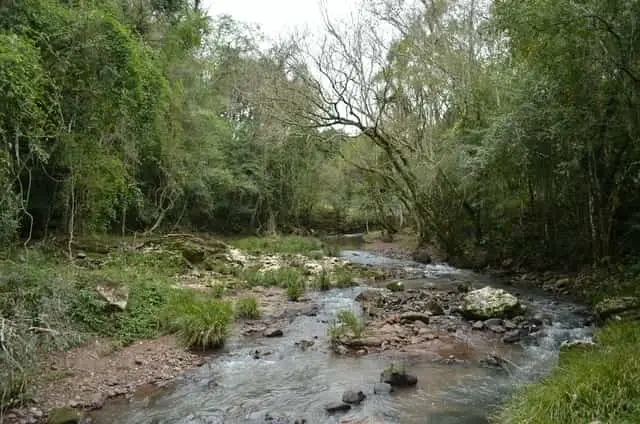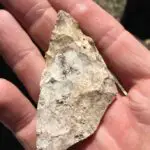
Arrowheads are authentic fragments of history and past cultural legacies that fascinate the young and old alike.
Finding arrowheads is an enjoyable and relatively simple task if you know where to look. Arrowheads can be found pretty much anywhere prehistoric cultures lived or traveled to, especially in rivers and creek beds.
With a few tips and arrowhead hunting techniques, you’ll be well on your way to finding a fragment of the past.
Note: The rules and regulations for hunting arrowheads and other primitive artifacts vary by state. Always consult the law and respect private and public property.
This page contains affiliate links. As an Amazon Associate, I earn from qualifying purchases.
Table of Contents
- How to Find Arrowheads in Creek Beds
- What do you Need to Go Arrowhead Hunting Near Creek Beds?
- Why are Arrowheads Commonly Found in Creeks?
- Conclusion
How to Find Arrowheads in Creek Beds
Cross-reference old maps with modern maps to identify creeks that Native Americans may have gathered to make camp. High bluffs or elevated mounds along waterways are a great starting area. The best time for arrowhead hunting in creek beds is when water levels are at their lowest and are exposing gravel bars.
But, before we dig into finding arrowheads in creek beds, it’s important to note that not all rivers, streams, and creeks were flowing the same way back then as now.
How to Search for Arrowheads in Creek Beds
Focus your efforts on creek bends with a build-up of debris and gravel bars, and other rocky areas. Flowing water sifts gravel into different sizes along gravel bars causing arrowheads to be caught between larger rocks.
- Walk along creeks and look for unnatural colored rocks and shapes.
- Keep your eye on the cut bank side of the creek where erosion exposes bare dirt.
- Look for points in gravel bars where rocks are similar in size to the points you’re hoping to find.
- Use your rake to remove most of the debris before using your trowel and sieve. It’s best if both your rake and trowel are plastic to ensure that you do not damage the artifacts.
- Use your trowel to scoop small amounts of sand. Then, use your sieve to sift and separate the sand from rocks and potential arrowheads.
- You can also scrape your spade between the exposed roots of trees growing at the edge of the creek; roots often trap small arrowheads.
Research Native American History
Go to a library or museum and read about Native American settlements and migration routes near your region.
Knowing their history gives a vast number of clues as to where to start your hunt.
Like mentioned earlier, ancient people lived and migrated along rivers and creeks for fresh water and other practical reasons.
Cross-reference old maps with modern maps to identify creeks where Native American hunters might have dropped arrowheads. For example, you may find that two streams converged in very different locations as they are currently joined.
Once you’ve done your research to identify the main locations for arrowheads, it would be advisable to talk to locals for some extra info on key spots for arrowhead hunting.
If you want to take extended measures, request soil records to make a better decision in choosing a search site. Soil records will tell you the following:
- Medium to large gravel: Any arrowhead can be found in this creek or river bottom type.
- Small gravel: a high chance of finding bird points (small arrowheads) and other small arrowheads.
- Pea gravel: better chance of finding bird points.
- Sandy bottoms: arrowheads are rarely found. You may find other artifacts, including pottery shards and flint.
Ask Permission to go Arrowhead Hunting
Unless you’re hunting on your own property, remember that it’s illegal to trespass and wander around someone else’s property. Ensure to ask permission from the landowner first or ask local authorities if you intend to go arrowhead hunting on public property.
Know What you are Looking for
Arrowheads can easily be mistaken for flat stones. As you scan the surfaces, chances are big chances that you may spot false arrowheads. So before picking random, worthless stones off the ground, familiarize yourself with what arrowheads look like.

Train your eyes to spot those irregular shapes (points, edges, stems, etc)
Native American arrowheads tend to resemble an isosceles triangle, and they are less than 2 inches in length. Most arrowheads are made of a knappable stone, which is almost crystalline, and fractures like glass. Flint, chert, and obsidian are prominent examples.
If you find ‘flakes’ or small chips and pieces of native material…you are likely in a good area.
Check to see if the artifact has a protrusion where it could’ve been attached to a shaft and whether flakes have been knapped off of the artifact’s sides to give it the right shape.
Determine The Best Time for Arrowhead Hunting
The best time to go arrowhead hunting in creek beds is during the time of the year that water levels are at their lowest.
Low creek beds are best for arrowhead hunting because creeks with low water levels expose more gravel bars where arrowheads are most commonly found.
Some creeks are seasonal and may be completely dried out for months. These dry creeks make excellent arrowhead-hunting grounds.
Hunting for arrowheads after rainfall or a flood is also a perfect time. The rain has most likely washed the top layer of soil away, exposing debris.
Study the Creek Bed
If you can locate a point where two or more large-sized rivers come together, you’ll probably also find evidence of an Indian camp close to the area.
The native Indians would not only have camped there, but they would have lived there for an extended period, making it an excellent spot for hunting arrowheads.
Study the creek bed to determine the direction the water flows when running. Not only did Indians camp by the water, but it was a favorite hunting spot when animals came to drink water.
Arrowheads and Spearheads are made of stone and have a flat shape; so, it often tends to sweep downstream when the water flows rapidly. So, the front side of a creek’s bend is the most probable area for an arrowhead to get washed. These bends are relatively easy to find; they usually have a more extensive accumulation of old branches and debris.
Also, look in the eroded side of creek beds that would typically be covered with water. Look for arrowheads along-and-inside water lines.
For those that prefer a visual image, here’s a short video on how to find arrowheads in creeks:
What do you Need to Go Arrowhead Hunting Near Creek Beds?
It’s always helpful to dress for the occasion and take a few tools along with you when arrowhead hunting.
Here are the most common tools you’ll need:
- Books and other resources about local native settlements
- Rubber boots
- A backpack for snacks and your search items
- Sieve
- Hand Rake
- Trowel
- Zip bags
Why are Arrowheads Commonly Found in Creeks?
Arrowheads can be found in numerous locations of the USA because the Native Indians were nomadic people, meaning that they moved from one camp to the next. Native Indians first introduced native American arrowheads during ancient times, thousands of years ago!
Without methods of storing and transporting water, they needed daily access to freshwater. So, they camped, traveled, and hunted near water systems.
Tools were often made, lost, broken, or left behind near these creeks or rivers. Arrowhead points later washed into creeks and rivers and became part of their gravel system over the centuries.
Not only did Native Indians camped near creeks, but it was also a favorite hunting spot when animals came to drink water.
Some people deliberately focus their time and energy on finding these ancient artifacts while others accidentally find them.
Conclusion
As you can see, creek beds are excellent spots for arrowhead hunting.
However, it saves a lot of time and energy to research before naively hunting in random areas.
The best time to go arrowhead hunting in creek beds is when the water levels are at their lowest or after heavy rains have ceded. Gravel bars and creek bends are great areas to spend your time searching for arrowheads.

Explore, be patient, and most importantly, have fun!
See Also: Are Arrowheads Worth Money?





